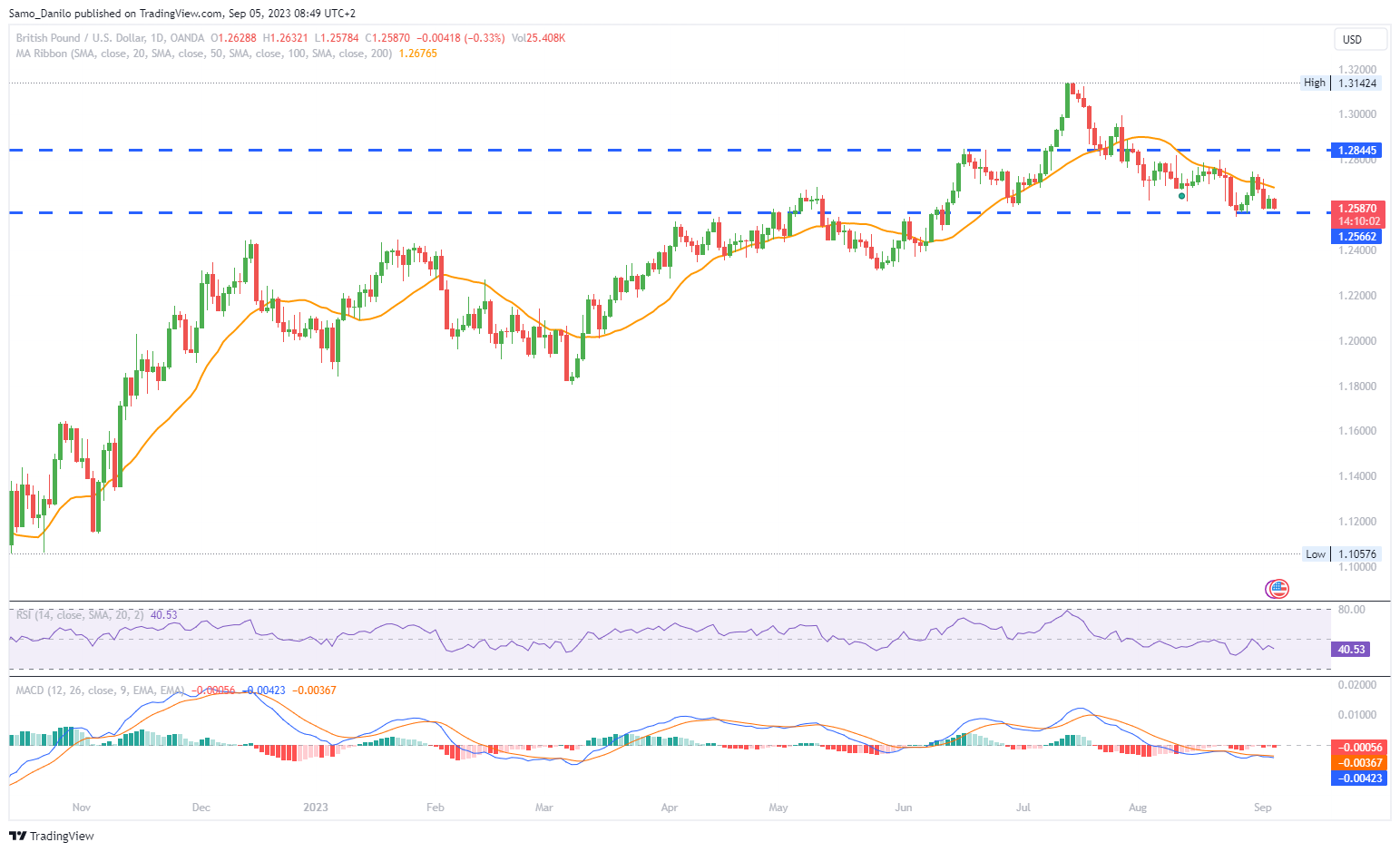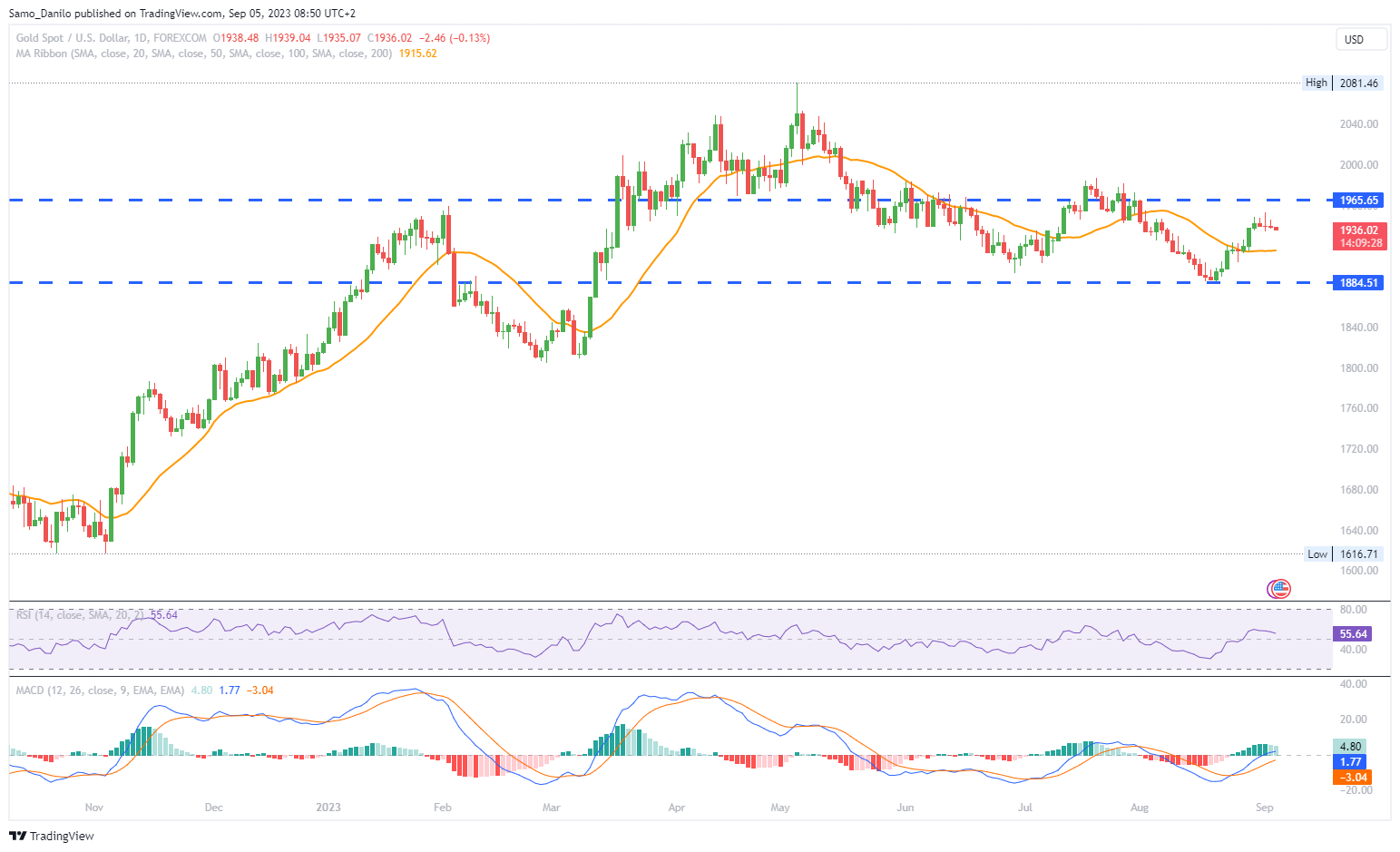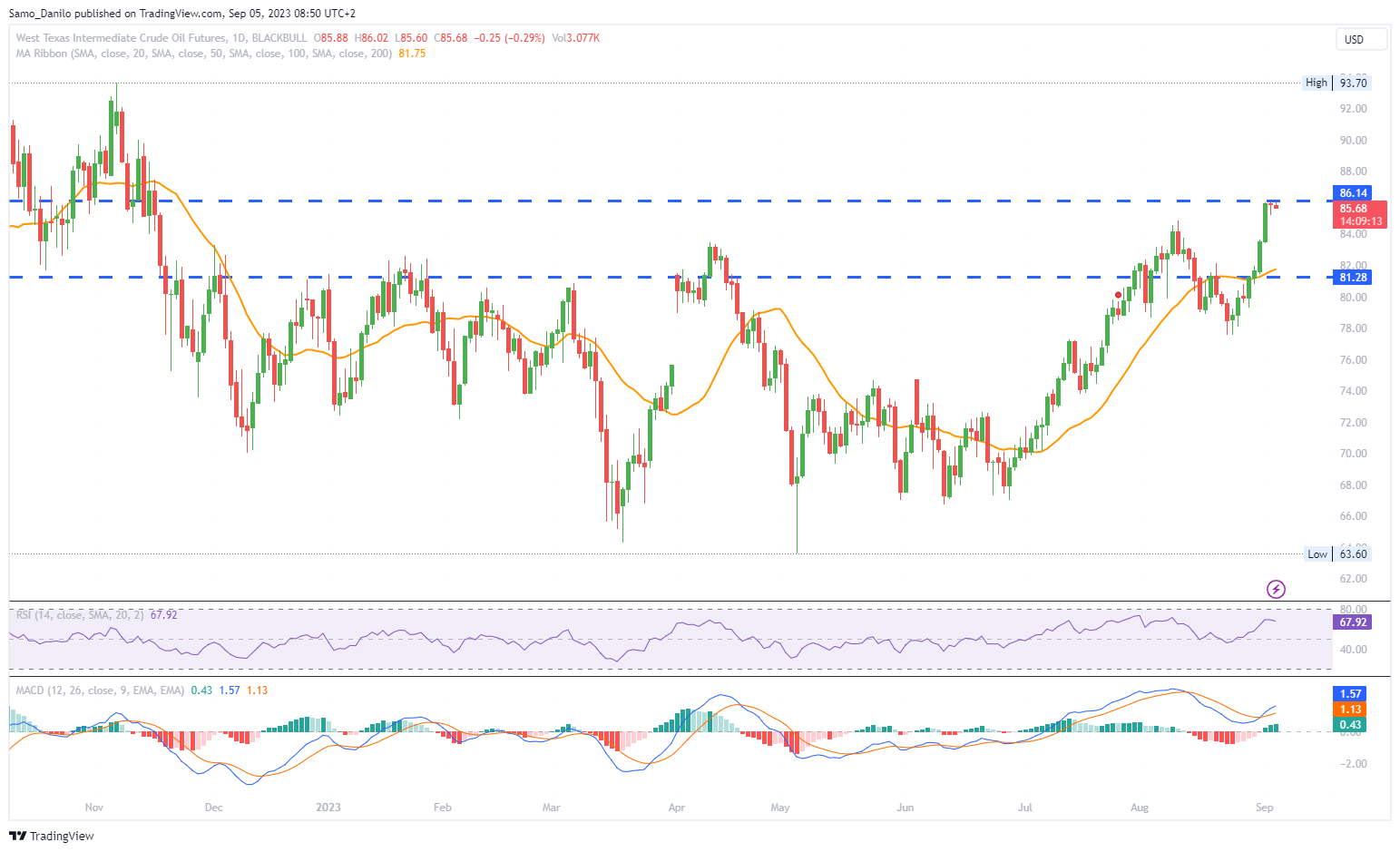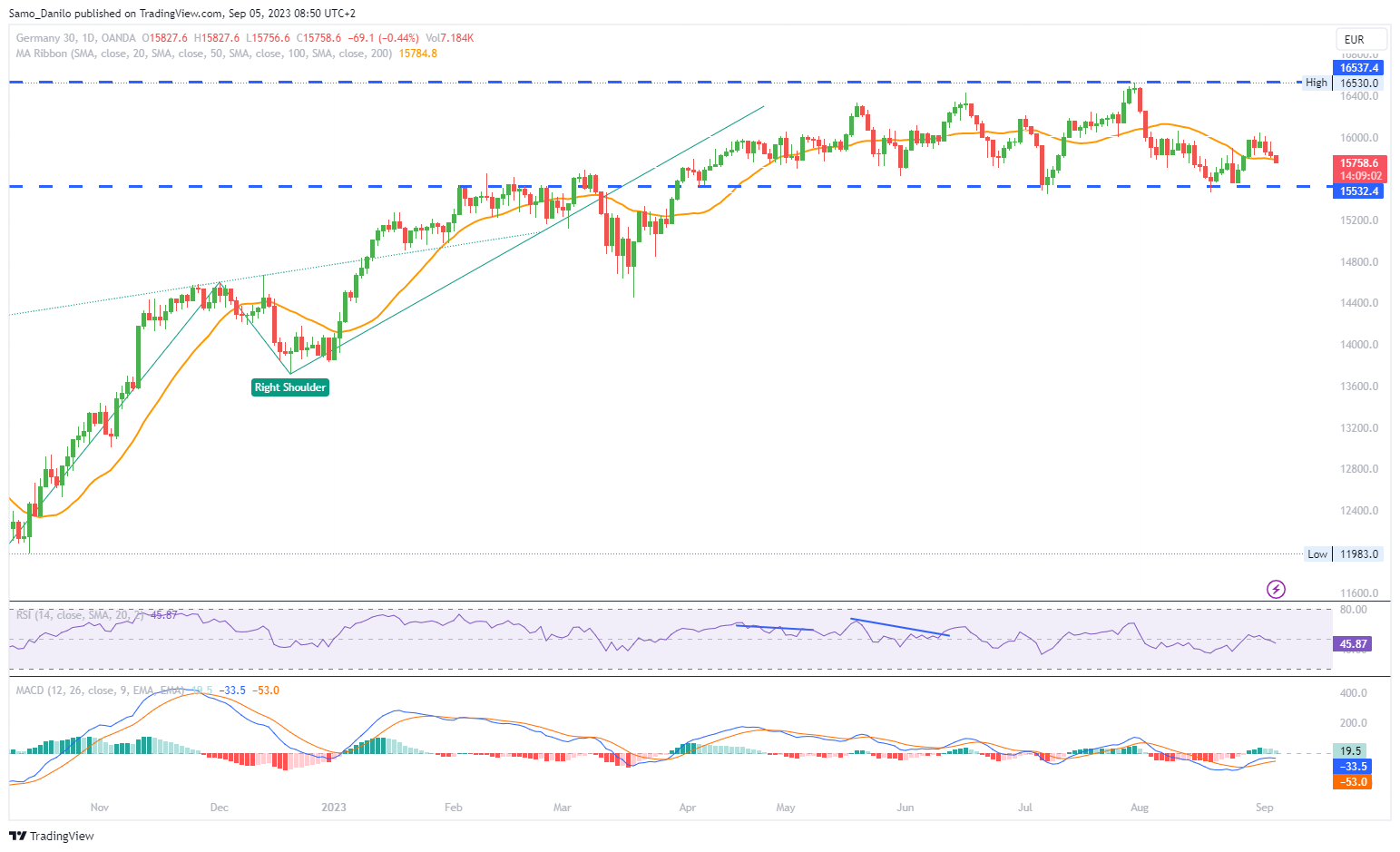EURUSD
- The EUR/USD is currently trading with minor losses around the 1.0780 level, as it interacts with a rising support line that has been in place for approximately 5.5 months. This support line represents a key technical level for the pair.
- The EUR/USD has experienced a reversal from its recent rebound off the mentioned support line. One of the primary reasons for this reversal is the lack of hawkish signals from European Central Bank (ECB) officials. Despite the ECB's focus on inflation expectations, relative price changes, and monetary policy, the comments from ECB President Christine Lagarde did not have a substantial impact on the market.
- On the economic calendar, the final reading of the Services Purchasing Managers' Index (PMI) for the Eurozone is scheduled for release. Market expectations do not anticipate any significant revisions, but unexpected changes in the data could impact the Euro's performance. Additionally, Eurostat will release the Producer Price Index (PPI) for July, with an expected annual rate of -7.6%, reflecting a decrease compared to June's -3.4%.
- The US Dollar experienced a modest pullback in the previous session, partly attributed to the closure of US markets. However, investors will closely watch the release of Factory Orders data on Tuesday, which could influence the direction of the US Dollar.
Closing statement: EUR/USD is currently testing a crucial support line as market participants closely monitor economic data and central bank signals. The pair's direction will depend on various factors, including the upcoming economic releases and any developments related to central bank policies.
GBPUSD
- GBP/USD continues to exhibit indecision among traders, with the pair hovering around the 1.2630 level as Tuesday's London session begins. This indecision can be attributed to mixed catalysts influencing the currency pair.
- GBP/USD's movements have been influenced by mixed factors, contributing to the lack of a clear trend. Additionally, cautious sentiment prevails in the market as traders await significant data releases from both the United States and the United Kingdom.
- The improving risk mood in the market is reflected in the UK's FTSE 100 Index, which opened higher and has been rising, currently up by 0.7% on the day.
- The recent release of the US Nonfarm Payrolls (NFP) data renewed a hawkish bias regarding the Federal Reserve's monetary policy. However, concerns related to the policy pivot remained on the table, particularly in light of the Unemployment Rate and Average Hourly Earnings data.
- The future direction of the GBP/USD pair will likely be influenced by economic statistics that suggest the stance of the Bank of England (BoE) compared to the Federal Reserve's capacity to maintain higher interest rates for an extended period. Any indications of a less dovish BoE relative to the Fed's monetary policy could result in a pullback for the currency pair.
| SMA (20) | Slightly Falling |
|
| RSI (14) | Slightly Falling |
|
| MACD (12, 26, 9) | Neutral |
Closing statement: GBP/USD is currently in a state of indecision as it navigates through mixed catalysts and market sentiment. The pair's direction will hinge on upcoming data releases and the relative positions of the BoE and the Federal Reserve in terms of monetary policy.
GOLD
- Gold prices exhibited minimal movement on Tuesday, lacking clear directional cues in the absence of significant recent developments.
- The US Dollar Index (DXY) recorded modest gains, hovering around 104.25. This followed a pause in its two-day uptrend, as it closely tracked the firmer US Treasury bond yields in anticipation of key US data releases.
- Federal Reserve Bank of Cleveland President Loretta J. Mester defended the hawkish stance of the US central bank in a speech on Friday. She ruled out any bias toward rate cuts, indicating the Federal Reserve's commitment to a more restrictive monetary policy.
- Expectations that the Federal Reserve will maintain higher interest rates for an extended period have limited investor appetite for gold. Recent labor and inflation indicators suggest that the central bank's stance will remain restrictive in the near term.
- In the near term, traders are likely to focus on the final readings of the UK PMIs for August, which could provide some intraday trading opportunities. Additionally, the release of US Factory Orders data for July will be watched for potential market impact.
| SMA (20) | Neutral | ||
| RSI (14) | Neutral | ||
| MACD (12, 26, 9) | Rising |
|
|
Closing statement: Gold prices remained relatively stable amid a lack of significant catalysts, while the US Dollar exhibited mild gains. The hawkish stance of the Federal Reserve, coupled with the anticipation of key economic data, has influenced market sentiment. Traders will monitor upcoming data releases for potential direction in gold prices.
CRUDE OIL
- Crude oil prices entered a phase of bullish consolidation during the Asian session on Tuesday. They oscillated within a range around the mid-$85.00s, just below the peak reached in 2023, which was touched the previous day.
- Crude oil experienced a robust uptrend over the past week, primarily driven by positive developments regarding supply reductions. Russia announced that it had reached an agreement with the Organization of Petroleum Exporting Countries (OPEC+) to implement further supply cuts. More details regarding this agreement are expected to be revealed in the coming week.
- Saudi Arabia, a key player in the production group, is anticipated to extend its ongoing one million barrel per day production cut until the end of October. The kingdom has signaled its commitment to maintaining lower production levels to support global crude prices.
- The potential for tighter oil supplies has been a significant driver for oil bulls. This outlook has overshadowed a mixed set of economic data from the world's largest oil-consuming countries.
- In China, both government and private surveys have provided mixed signals regarding manufacturing activity. This reflects the challenges the world's largest oil consumer faces in stabilizing its post-COVID economic recovery.
| SMA (20) | Slightly Rising |
| |
| RSI (14) | Slightly Falling |
|
|
| MACD (12, 26, 9) | Rising |
|
|
Closing statement: Crude oil prices have been in a bullish consolidation phase, driven by optimism surrounding supply reductions resulting from agreements between major oil-producing nations like Russia and Saudi Arabia. Despite mixed economic signals from major oil-consuming countries, the prospect of tighter supplies has bolstered oil market sentiment. Traders will continue to monitor developments in the oil supply landscape for further cues.
DAX
- The DAX, the German stock market index, closed at 15,825 with a slight dip of 0.1% on Monday. This decline reflects the economic challenges faced by Germany.
- Germany's trade surplus significantly narrowed in July. This was attributed to a notable increase in imports combined with a decline in exports. Trade terms with non-EU countries highlighted the prevailing weak global demand environment, impacting Germany's trade dynamics.
- The Sentix Index sounded warning signals as it reached -21.5. This indicated challenges in the services sector, which was moving into contractionary territory. The services sector plays a crucial role in the Eurozone economy, and weaker figures here could send additional economic warnings.
- On Monday, US markets were closed for Labor Day. The DAX faced a deteriorating macroeconomic environment and a commitment from ECB President Christine Lagarde to tackle elevated inflation, which contributed to its negative performance.
- Euro area services PMIs will be of particular interest. Given that the services sector is a major contributor to the Eurozone economy, any signs of weakness in these figures could further impact investor sentiment. Preliminary figures indicated a drop in the German services PMI from 52.3 to 47.3. Coupled with a manufacturing PMI below 40, a downward revision could have implications for the market.
- ECB President Christine Lagarde is scheduled to speak, and her comments will be closely watched for insights into potential further actions by the ECB. Additionally, ECB Executive Board Members Edouard Fernandez-Bollo, Luis de Guindos, and Isabel Schnabel will also be subjects of interest.
| SMA (20) | Neutral |
| RSI (14) | Neutral |
| MACD (12, 26, 9) | Neutral |
Closing statement: The DAX faced challenges due to Germany's economic struggles, reflected in a narrowing trade surplus and weak services sector data. The market is eagerly awaiting the outcome of Eurozone services PMIs and ECB officials' statements for potential clues on future economic and monetary policy actions.





